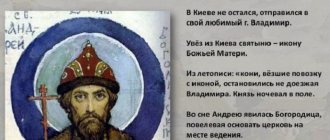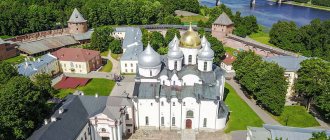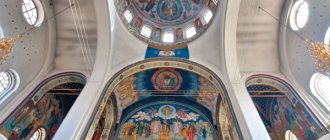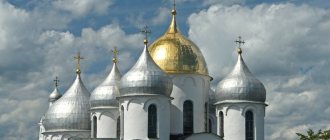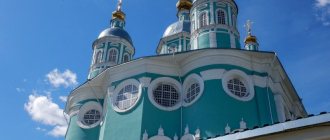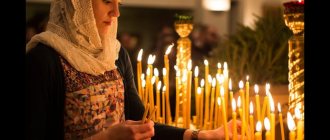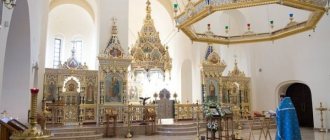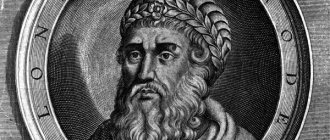The opening of the cathedral was waited for 17 long years. The construction of the Armenian Cathedral began in 1996, but due to some events, as well as due to a lack of funds, construction was stopped for a while. The complex was opened in 2013; this event was one of the most important not only for the Armenian diaspora, but also for Muscovites. Outside of Armenia, such a majestic temple of the Armenian Apostolic Church does not exist anywhere else. We'll tell you more about it in the article.
Armenian Cathedral. Description of the temple
The Armenian temple complex in Moscow is the residence of the Patriarchal Exarch, as well as one of the spiritual centers of Armenians in Russia. The complex buildings are made in a light ocher shade, among them rise the rich, bright forms of the walls of the cathedral. To decorate them, they used pink Ani tuff, which was specially brought from Armenia; a total of 100 wagons of material were required. The facades are completely decorated with belts with carved ornaments, with various bas-relief decorations that depict common Christian saints, as well as the holy faces of the Armenian Church.
The Armenian Cathedral in Moscow was built according to strict Armenian canons. Reviews from those who were lucky enough to participate in or witness the construction confirm how much effort and effort was put into every brick of the temple. Architect Artak Gulyan is the author of the project. The temple is located on a stylobate - this is a church foundation characteristic of all Armenian cathedrals. The temple can be seen from afar, but if you come closer to it, you can see a seven-meter figure of Christ on the main facade. The façade itself resembles a picture book. With the masterful hand of Ashot Adamyan, the entire history of the Armenian religion is depicted here. It's not just the façade that is unique. The interior is also conceived as a continuation of the history of Orthodoxy of the Armenians. Travertine, reminiscent of white marble and wood, was used as finishing here.
Armenian temple complex
The Cathedral Temple and the Residence of the Patriarchal Exarch of the Head of the New Nakhichevan and Russian Diocese of the Armenian Apostolic Church is an Armenian temple complex - the largest religious building of the Armenian diaspora in Moscow.
On September 17, 2013, the Armenian temple complex
. Catholicos of All Armenians Karekin II consecrated the cathedral, designed for 1000 parishioners. About 700 thousand people took part in the ceremony.
Present were not only the head of the New Nakhichevan and Russian Diocese of the Armenian Apostolic Church, Bishop Ezras (Narsisyan), who directly supervised the construction of the complex since 2006, and the President of Armenia Serzh Sargsyan, but also many representatives of all kinds of Christian denominations, and even representatives of other world religions - Judaism , Buddhism and Islam.
The complex consists of the majestic Transfiguration Cathedral, the chapel of Surb-Khach (Holy Cross), as well as administrative, educational and educational buildings and a guest house. On a huge area of 25 thousand square meters. m. there was enough space not only for the residence of the Catholicos of All Armenians, but also for a museum-treasury, a gymnasium, a library, a refectory and even a parking lot.
The pearl of the complex, naturally, is the Cathedral of the Transfiguration of the Lord, built in the best traditions of classical Christian Armenian architecture. It rises on a two-level stylobate (a plinth that unites the entire complex) and reaches a height of 58 m, together with the main cross (cast in Tula and weighs more than 2 tons), which was raised onto the faceted hipped dome of the temple in October 2011. Bookmark The memorial stone for the foundation of the cathedral took place in 2004, so construction took more than 8 long years. And if you consider that the land for the complex was allocated back in 1996, then you can imagine how impatiently the Armenian diaspora was waiting for its opening.
16 stones consecrated with myrrh were laid at the base of the building: 12 - in honor of the 12 apostles closest to Christ, 3 - in honor of the three evangelists and one more - in memory of St. Gregory, the Illuminator of Armenia. The high walls of the Transfiguration Cathedral, lined with ocher-orange tuff brought from Anipemza (a deposit in Armenia) and enhancing the national flavor, are decorated with fine stone carvings and wonderful bas-reliefs depicting Christ (the height of the figure is 7 m) and saints, both common Christian and Armenian , as well as various scenes from the Christian history of Armenia. In addition to tuff, granite, travertine and marble were used for finishing work.
There are also deviations from traditional Armenian forms. For example, the Transfiguration Cathedral has 5 chapters, and not one, as was previously customary in Armenian temple architecture. And, in general, the forms of the cathedral are still very close to modern ones. The author of the complex project was the famous architect Artak Ghulyan. And Ashot Adamyan is the author of the bas-reliefs. About 10 Armenian master sculptors created this stone miracle - the Cathedral of the Transfiguration.
The diameter of the dome, mounted on a massive drum, is 21 m. The entire surface of the dome is covered with carved crosses according to the number of junior disciples-apostles – 72.
7 apses frame the interior of the temple, which is close in shape to a regular circle. More than a thousand square meters of walls are covered with exquisite paintings.
No less interesting is the Surb-Khach church-chapel. Even the doors to it are marvels of carving. Its interior decoration is no less magnificent than that of the cathedral.
It remains to add that, although the Armenian Apostolic Church is called in an expanded version - the Armenian Holy Apostolic Orthodox Church, since 451 (Council of Chalcedon) it has not been in eucharistic unity with the Russian Orthodox Church. Significant features in dogma and ritual distinguish it from other Christian churches, both Byzantine Orthodox, Catholic and Protestant. This, however, does not interfere with fraternal friendship with the Russian Orthodox Church, in honor of which the consecration ceremony of the complex continued with the opening of a monument-spring in its courtyard, a symbol of the fraternal relations of the two Churches - the Russian Orthodox and the Armenian Apostolic.
Armenian temple complex
Currently, it is the second national cultural and educational center of the Armenian Church after Etchmiadzin, and also the largest and most modern.
Style
The Armenian Cathedral, the sculptural temple volume of which is completely based on the tradition of Armenian architecture, is made in the classical style. The interior space of the cathedral is as close as possible to a circular shape, framed by seven asps. At mark +11 there is a tier-balcony, specially erected for the choir. Raisa Gadzhyanova assessed the acoustic data of the room during construction. The stylobate of the temple is made on two levels, it is paved with granite slabs and granite paving stones. The drum rests on eight pylons. Individual triangular edges in the form of folds form a tent. Retaining walls, parapets - all this is lined with tuff of various shades, the floor is covered with granite and marble. Skillful stone carving was used as decoration both inside and outside, performed by the best masters of Armenia. The Armenian Cathedral, the architecture of which delights all parishioners, reaches a height of fifty meters, if you do not take into account the height of the cross. The width of the cathedral is 35 and the length is 40 meters. It can accommodate up to a thousand parishioners at the same time.
Consecration of the Cathedral of the Armenian Church
In 2013, a grand event took place on Olympic Avenue. The Cathedral of the Armenian Church was consecrated. The temple is now the center of the Russian and New Nakhichevan diocese. Present at this high-profile event were Serzh Sargsyan, the President of Armenia, Armenian bishops from different countries, Patriarch Kirill and other leaders of Russian faiths. Karekin II named the cathedral in honor of the Transfiguration of the Lord. Before the service, none of those present knew what saint or divine holiday the temple would be dedicated to. Catholicos Karekin II presented as a gift at the consecration a piece of the Cross on which Christ suffered his torment, as well as a silver lamp, which will be a symbol of the light of Christianity, faith, goodness, love, spiritual community.
Operating mode
The Armenian Church is open to visitors any day. Opening hours: 09:00–19:00 hours. Services in the Armenian Church in Moscow take place at the following times:
- Daily : 10:30 - morning service, 16:30 - evening service.
- Sundays : 11:00 - Holy Liturgy.
Baptisms and weddings are also performed in the Armenian Church in Moscow. According to reviews, these sacraments take place in the Cathedral of the Transfiguration of the Lord in a particularly majestic setting. Travelers recommend going inside, even if there are no services there, to look at the beautiful interior design.
Opening hours of the Armenian Church in Moscow (official website)
Panoramic view of the entrance to the Armenian Apostolic Church in Moscow:
Patriarch Kirill at the opening
Patriarch Kirill was present at the consecration ceremony. On behalf of all Russian believers, he thanked the Armenian diaspora for making every effort to ensure that the Armenian Cathedral began to operate in Moscow. The Patriarch emphasized that Russia, together with Armenia, is making every effort to revive the Christian faith in the post-religious 21st century. As His Holiness said, cathedrals are not built to become monuments or to remind of the work of the builders, but so that people gather in them to pray, to communicate with God. Currently, the world is doing everything to ensure that God’s word is forgotten; the task of the church is to restore faith and show that God’s ideas are alive today. Parishioners of the Russian Orthodox Church cannot receive communion in Armenian churches. But the brotherhood and cooperation of the AAC and the Russian Orthodox Church has been observed for many centuries. Spiritual ties between peoples are growing, and this is more than economic or political cooperation.
home
Armenian Apostolic Holy Church
The Armenian Apostolic Holy Church (AAC) is one of the oldest Churches in the world. The Armenian Church was founded by the Holy Apostles of Jesus Christ - Thaddeus and Bartholomew, who preached in Armenia in the first century, and is therefore called “Apostolic”. According to legend, Apostle Thaddeus preached in Armenia from 35 to 43, and Apostle Bartholomew preached in Armenia for 16 years (40-60s).
The Armenian Church has been formed over the years as an independent, national Church. Its confession is based on the Bible and the decisions of the first three Ecumenical Councils - Nicaea (325), Constantinople (381) and Ephesus (431).
The spiritual and administrative center of the Armenian Church is the Mother See of Holy Etchmiadzin.
The Armenian Apostolic (Orthodox) Church has a special calendar in which most holidays are celebrated on a specific day of the week, and therefore the date of their celebration changes from year to year. The basis of the AAC calendar cycle is Easter (Զատիկ), which in different years can be celebrated from March 22 to April 25. In addition to Easter, there are 4 more holidays, the dates of which are the starting points for establishing the dates of other holidays: Epiphany (Christmas and Epiphany) - January 6, Assumption of the Virgin Mary - the Sunday closest to August 15, Exaltation of the Life-Giving Cross of the Lord - Sunday closest to September 14, Maslenitsa Fasting of the Nativity Pentecost is a Sunday falling between November 15 and November 21. In accordance with the dates of these holidays, days of remembrance of Saints and fasts are also established.
The Lord's holidays are those that are dedicated to the memories of the events of the earthly life of the Lord Jesus Christ, the Blessed Virgin Mary, as well as holidays dedicated to the Holy Cross and the Holy Church. Five of the Lord's holidays are called Great.
The great holidays of the Armenian Apostolic Church are:
1. Christmas and Epiphany (January 5-6),
2. Easter (Resurrection of the Lord Jesus Christ),
3. Transfiguration of the Lord on Mount Tabor (Vardavar),
4. Dormition of the Blessed Virgin Mary (celebrated on the Sunday closest to August 15),
5. Exaltation of the Life-giving Cross of the Lord (Sunday falling between September 11 and 17).
The day following the Great Holiday is the day of obedience to the dead (“Merelots”, “Մեռելոց”).
In the AAC calendar, all Sundays are reserved for the Lord's holidays or are days of remembrance of the Resurrection of Christ. All Wednesdays and Fridays are fast days. On Wednesday, fasting is observed in memory of the suffering of Jesus Christ, and on Friday - in memory of the death of the Savior.
The Armenian Cathedral in Moscow is a monument to the Russian-Armenian brotherhood
The new temple was called by the priests a man-made monument to alliance and Russian-Armenian brotherhood. The common heroic past, the spiritual unity of our two peoples are recalled, the dynamism of present relations and a promising future are noted. This cathedral, built in Moscow, is a song to the mutual penetration of our hopes and aspirations, souls and hearts, thoughts. The Armenian diaspora believes that the new temple is a page of the fruitful presence of Armenia and its church in the fertile, friendly land of Russia. This is a memory to all our previous generations, our ancestors, who ordered us to cherish the relationship and friendship between the two peoples like the apple of our eye. This is an obelisk to all those who laid down their lives for our conflict-free coexistence in this world. This is a tribute to the memory of those church ministers who, during the difficult years of persecution and repression, did not betray their faith, but carried the truth of Christ and fulfilled the mission of a preacher and shepherd.
Glory to the creators of the temple
The Cathedral of the Armenian Apostolic Church was built thanks to the efforts of the Armenian diaspora. Words of gratitude and glory were sung to the benefactors. The Life-Giving Temple was called the construction site of the century. Praise be given to the wisdom and courtesy of the head of the AAC, His Holiness Catholicos Karekin II, he carries within himself the talent of all his predecessors. It was through his efforts and consistent actions that the Armenian Church was able to emerge in the capital of Russia. The life-giving rainbow united the Russian Orthodox and Armenian Apostolic churches, the brothers in Christ, His Holiness Patriarch Kirill and Catholicos Karekin II. Their Holinesses teach us day and night to create and create in the name of strengthening our Christian brotherhood.
The head of the church, Erzas Nersisyan, played a significant role in the construction of the temple. The temple can be called his brainchild, the crown of his activities on Russian soil. Like an ordinary worker, he rolled up his sleeves and walked through the entire construction site, starting from the first brick. He was a diligent builder, a designer, an architect, an inspirer, and a manager of construction work. Of course, this complex will become the center of all Russian Armenians. I would like the beautiful temple to become one of the places of pilgrimage not only for Armenian, but also for Russian parishioners, and to attract the attention of all believers.
Hierarchy
The CATHOLICOS is the spiritual leader of the entire Armenian people, the shepherd and patriarch of about 9 million Armenians of the Armenian Church scattered throughout the world.
At the highest level of the hierarchical ladder of the Armenian Church is the Catholicos of All Armenians. Having received the grace of the Holy Spirit at ordination, he also receives the power to transmit it to the bishops, who, in turn, transmit it to the priests at ordination, and the latter to the people. So, the hierarchy of the Armenian Church includes three main degrees of priesthood, whose representatives, through ordination and confirmation, receive the grace of the Holy Spirit and the power to transmit it to others.
In the hierarchy of the Armenian Apostolic Church, the head of the Church - the Catholicos (from the Greek katholikos - “universal”) - is one step above the bishops; he receives ordination and confirmation from 12 bishops.
The official title of the Catholicos is His Holiness the Supreme Patriarch and Catholicos of All Armenians. In official documents, which are the Kontakia, the full title reads as follows: “Garegin II Servant of Jesus Christ, by the grace of God and the will of the people, High Hierarch and Catholicos of All Armenians, Supreme Patriarch of the nationally venerable Ararat Throne of the Apostolic Church of the Mother See of Holy Cathedral Etchmiadzin.” In addition to the title, the insignia of the Catholicos of All Armenians are the coat of arms, seal, veil with the image of the Lamb, banner, large and small staffs, club, throne, tents (honorary retinue in red robes with maces in their hands), a diamond cross on the hood.
Unlike the Orthodox Church, in the hierarchy of the Armenian Apostolic Church the head of the Church, the Catholicos, is one step above the bishops; he receives ordination and confirmation from 12 bishops. The Catholicos represents the centralized authority of the Armenian Church. He is the chief legislator and supreme judge. Its competence includes the ordination of bishops, the consecration of St. peace, the publication of new laws and the blessing of new holidays, the founding of new dioceses. He is the supreme custodian of the sacred relics and treasures of the Church, the spiritual father of the nation and the Supreme Patriarch. The Catholicos is elected by the Church-National Council for life.
His Holiness the Supreme Patriarch and Catholicos of All Armenians represents the highest centralized ecclesiastical authority of the Armenian Church, supervises all church institutions, is the guardian of dogmatic teaching and the guardian of the right faith and church piety, the chief legislator and the supreme judge. In the Armenian Church, the Catholicos is elected for life. The election of the Catholicos is carried out by the National Church Council, the highest body of the Armenian Church, which convenes in the Mother See of Etchmiadzin. The competence of the Council also includes issues of church legislation and canons, changes in customs and rituals, and supreme supervision of governance and hierarchical structure. The Council is composed of both clergy and laity, representing all ecclesiastical dioceses and communities of the Armenian Church throughout the world. Usually there are from 300 to 400 representatives present at the Council. As a rule, the Catholicos is elected from among the bishops. The elections are divided into two stages. At the first, five bishops, applicants for the rank of Catholicos, are elected by secret ballot based on the majority of votes cast. At the second stage, by secret ballot, the Catholicos is elected from among the previously elected five bishops. Now on the Etchmiadzin Throne is the 132nd successor of St. Gregory the Illuminator Catholicos Karekin II, elected on October 27, 1999. The Supreme Spiritual Council operates under the Catholicos. Currently it consists of 2 Patriarchs, 10 archbishops, 4 bishops and 5 laity.
Bishop is the highest level of the church hierarchy. The bishopric represents the unity of the Church. A bishop is the head and spiritual leader of all churches of one political-geographical region (diocese). The bishop has the right to ordain and anoint deacons, priests and consecrate churches. In the Armenian Church, a bishop is ordained and receives confirmation from the Catholicos. During ordination, the bishop receives the bishop's staff and ring as a sign of authority. Bishops are elected from among the celibate clergy who have the academic degree of archimandrite. For special services to the Church and long service, a bishop may be awarded the title of archbishop.
The second, main level of the church hierarchy is ordination to the rank of priest. Only a deacon can be ordained to the priesthood. Priests can perform all sacraments and church services, except those that are supposed to be performed only by the bishop, i.e. except the sacrament of ordination (priesthood) and the consecration of the world. The duty of a priest is shepherding, i.e. care for the spiritual rebirth of people, the spiritual education of believers, as well as the performance of sacraments, divine services and services. More worthy and honored priests are given the title of senior priest. In the Armenian Church, as in the Orthodox Church, priests are both married and celibate. In order to become a priest, the chosen one must be married for at least a year and have a son. The hieromonk (celibate priest - abeha), after ordination on the same day, takes a vow of celibacy and puts on a vegar (a special headdress - hood) as a symbol of renunciation of the world.
The first step in church initiation is deacon (sarkavag). Deacons serve the bishop or priest during worship and the celebration of the sacraments, but cannot perform them themselves. Some deacons are awarded the title of senior deacon. Deacons are ordained from among the readers serving in the church. The readers (dpir), in turn, are divided into psalm-readers, sextons, lamplighters and key-keepers.
Academic degrees of the Armenian Church
The Armenian Church assigns two degrees of learning to its ministers:
- Archimandrite (vardapet) – corresponds to the degree of candidate of sciences,
- Protoarchimandrite (tsayraguyn vardapet) – corresponds to the degree of Doctor of Science. Academic degrees are awarded only to celibate clergy. Only those bishops who have the title of Supreme Archimandrite have the right to confer academic degrees. When conferring an academic degree, the archimandrite is given a staff with a two-headed snake, which symbolizes wisdom and the authority given to him to teach and preach.
Interesting Facts
For the construction of the temple, a site was allocated back in 1996; it was located at the address: Trifonovskaya, 24, an area adjacent to Olympic Avenue. The construction of the cathedral was planned to be completed in five years and opened in 2001. However, an unpleasant story disrupted these plans. In 2000, the head of the New Nakhichevan and Russian AAC, Archbishop Tigran Kyuregyan, was accused of embezzling a huge amount donated for the construction of the temple ($3 million). In 2001, the archbishop was defrocked. In 2005, the court declared this information invalid. However, funds were never found, and the new bishop Erzas Nersisyan had to again collect bit by bit funds for the temple. According to the head of the diocese, the complex was built according to a new project, the author of which was the architect Artak Ghulyan. Construction began in 2006 and was completed in 2013.
